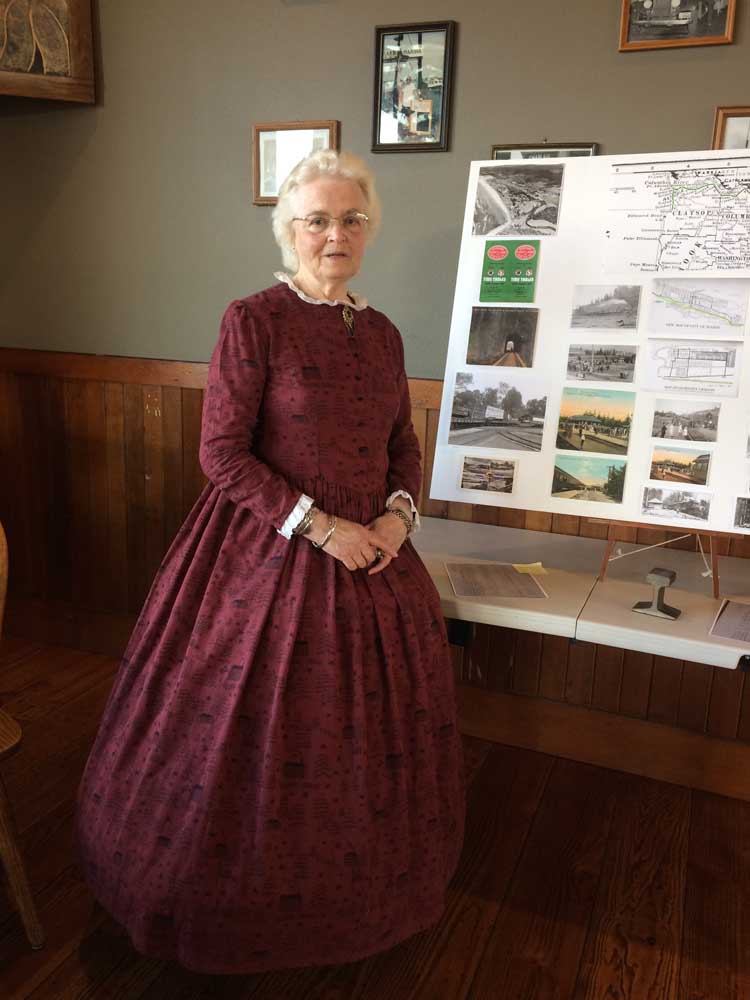All aboard the Daddy Train!
Published 3:12 pm Thursday, October 26, 2017

- Susan Glen, dressed in 1800 clothing styled for travel, stands next to a display of information about the railroad system in Clatsop County. Maps display the routes from Portland to the coast, Astoria to Gearhart and to Seaside, along with vintage photos and postcards.
The emotional connection of families reunited in the summer at the beach is passed from generation to generation.
The coastal enclave to escape the summer heat in Portland included Seaside, Gearhart, Warrenton and Astoria, but Seaside and Gearhart were the favorite home-away-from-home getaways for many Portlanders.
Families who could afford to spend the summer on the coast did, and wealthier families included their maids, butlers and chauffeurs as well. However, fathers stayed behind to work, traveling to the coast Saturday morning and returning Sunday evening for work on Monday morning. Local author Susan Glen has penned several books on towns in Clatsop under the “Images of America” series. She not only spoke of the coastal railroad’s beginnings, timeline and the Daddy Train on Sept. 28 at Seaside Brewing Co., she came dressed in similar fashion worn by women traveling on the trains from that era.
“The train that became known at the ‘Daddy Train’ eventually went all the way to Portland, around the coast to Seaside,” Glen said.
By the early 1900s, the moniker “Daddy Train” became synonymous for this special weekend service. The cost to travel the train was two cents a mile in 1907, eventually increasing to $5.
Businessmen could also travel from Portland to Astoria by steamboat via the Columbia River then board the train southward to Seaside.
Nonetheless, the continuation of paved roads and the popularity of automobiles ended the Daddy Train rail service in 1938.
The story of the railroad system in Clatsop County dates back to the late 1800s. It was a mere microcosm of the larger rail system spanning across the United States as it connected its eastern shores to its west.
There were no dress codes for riding on the trains, Glen said, explaining, “They wanted to make it so people would feel comfortable coming to the Coast,” even though some towns, but not all, had dress codes.
Her presentation “Riding the Rails” was the first of the season’s History & Hops speaker series co-sponsored by the Seaside Museum & Historical Society and Seaside Brewing Co.
In 1883, the Northern Pacific finally reached Portland, however, the railroad was over-extended financially and stopped short of reaching Astoria. This made Portland the western transit hub for the railroad.
Around 1858, William Reid, backed by C.P. Huntington, began grading a roadbed from Astoria south along the coast in hopes to connect with Ben Holliday’s Oregon & California rail line in Hillsboro. That did not happen and eventually, Astoria dropped Reid and the deal failed. However, Reid had completed a line to Seaside.
According to Glen, a narrow gauge railway line began in 1886, and in August 1888, the Astoria South Coast Railway was formed. A group of businessmen including D.K. Warren, James Taylor and Alfred Kinney sold 2,655 and one-half shares for $100 each to purchase a Westinghouse locomotive. That same year, 14 miles of track were laid from Youngs Bay to Gearhart encompassing 20 curves and 16 trestles.
By 1896, the railroad across Youngs Bay was completed. In 1898, the Astoria tracks connected to Northern Pacific’s tracks in Goble with a 99-year lease for service to Portland.
In 1899, rail lines went to Fort Stevens and in May that year, a depot was built in Seaside for the Astoria and postal railroad.
• Tickets from Seaside to Portland in 1903 were $1.
• The train ride from Portland to Seaside took five hours.
• The first passenger car was a boxcar — holes were cut out for windows, upright chairs used for seating and passengers had to carry umbrellas.
• Delmoor Station — later called Clatsop Platform and located across the road from Camp Rilea — was originally Camp Clark.
• Passenger service to Seaside stopped in 1952, and by 1978, the line to Seaside was abandoned completely.
• In 1929, timber was transported from Astoria to Boston for repairs on Old Ironsides — also known as USS Constitution, the world’s oldest sailing ship afloat. Once repaired, the ship sailed to Astoria in gratitude.
• From 2003 to 2005 the State of Oregon, together with Portland & Western Railroad and Amtrak, ran the Lewis and Clark Explorer Train from Portland to Astoria, and back.

